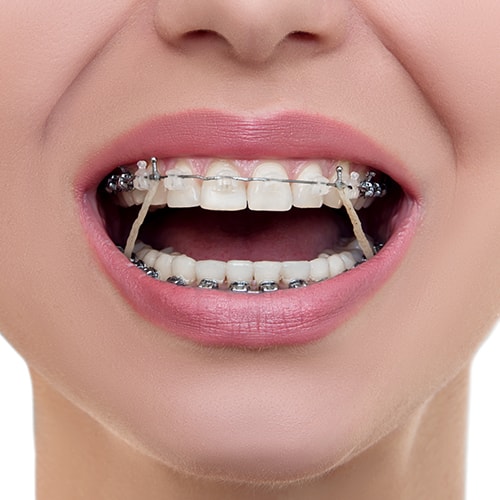When you get braces, your orthodontist may recommend you use elastics as part of your orthodontic treatment. This is an indication that you need a little extra help from these tiny rubber bands to move your teeth into place.
Different Kinds of Elastics
There are actually a couple different types of elastics. Everyone with traditional braces uses the rubber bands that are looped around each bracket to hold the arch wire in place. These rubber bands are called ligature tires and should only be removed or replaced in your orthodontic office.
The other type of elastics is interarch rubber bands. These are used to correct your bite alignment. These will be hooked on each side of your mouth, stretching from your top canines to your bottom molars or vice versa depending on your bite.
What Do Orthodontic Elastics Do?
Interarch rubber bands have a more specific purpose than the ligatures that hold the wire in place. They are used during the bite alignment phase of orthodontic treatment; in which your orthodontist plans to correct the way your teeth are positioned within the jaws. While the brackets and wires will fix your crooked teeth, elastics are used in the more difficult process of fixing your bite.
Remember these aren’t normal rubber bands like you’d use around the house. Your orthodontist will give you special elastics specifically to be used inside your mouth.
Read out blog about bite alignment to learn more about how elastics can help!
Wearing Your Elastics with Your Braces
Here are some tips for wearing elastics and what to expect when you first get them:
- Your elastics should be worn at all times or as instructed by your orthodontists.
- They can be removed during meals and when you brush and floss, but you should replace them as soon as you finish.
- Your orthodontist will give you plenty of replacements so that you can put new rubber bands in when your current one’s break.
- You will also be instructed on how to insert and take out your elastics so you are comfortable doing it every day.
- Even if they aren’t broken, you should change your elastics at least every 8-12 hours to make sure you’re using rubber bands with the highest strength.
- The pressure from the elastics moving your teeth and jaw will cause some discomfort, but over time, it should start to minimize.
- Over-the-counter pain medicine may be taken if the elastics are causing any kind of discomfort.
- Sometimes the rubber bands can break while in your mouth. It may surprise you when it happens, but it doesn’t mean anything is wrong. Just be sure to replace them with new elastics.
While elastics are important, not everyone with braces will need them. Be sure to talk to your orthodontist about your possible orthodontic treatment plan when you go in for an exam.
For more information about elastics and if you might need them, call us today at (843) 4-BRACES and schedule a free exam in Mt. Pleasant orthodontist office or one of our other convenient locations.



